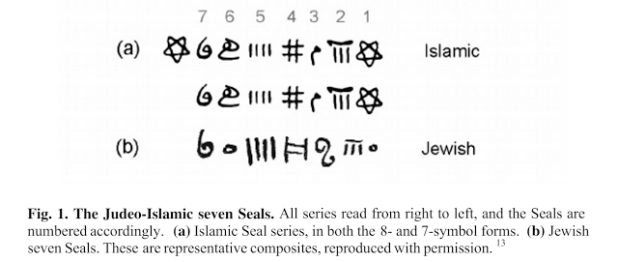Diversity Macht Frei
March 8, 2016
Two of the most striking graphic features of Islamic grimoires and amulets are the inclusion of charakteres (i.e., the spectacle-letters, lunette sigla or brillenbuchstaben of Late Antique magic) and – from the 13th century CE onwards – the presence of the distinctive symbol series known as the Seven Seals, which is believed to constitute the Greatest Name of God (Fig. 1a).
Accordingly, these two sets of glyphs form the focal points of Dr. Hans Winkler’s major survey Siegel und Charaktere in der Mohammedanischen Zauberei, first published in 1930 CE. In it Winkler posits an origin for the charakteres in cuneiform, and contrasts their global diffusion after the decline of the Assyro-Babylonian culture with the much later appearance of the Seven Seals, which – in his view – united elements of Judaism, Christianity and Islam, but were nevertheless restricted to the Muslim world of the second millennium CE.
Charaktere glyphs and the Seven Seals also co-appear in Jewish Kabbalah, where the latter symbols (Fig. 1b) again date back to the late 13th/early 14th century CE. No prior or external source has been recognized thus far for the Kabbalistic Seven Seals, beyond the obvious possibility of their recruitment from the Islamic magic of the same region and era.
It remains unclear as to whether the symbols were borrowed by Judaism from Islam or vice versa ; indeed, this may prove to be a question without a meaningful answer. Speaking of the 9th to 12th centuries CE, Steven Wasserstrom observes that “the ‘creative symbiosis’ between Muslim and Jew extended deeply into the magical realm.” Thus early components of the Seal symbol repertoire – and later the emerging series as a whole – may have trafficked repeatedly between the two cultures, all the while continuing to evolve.
